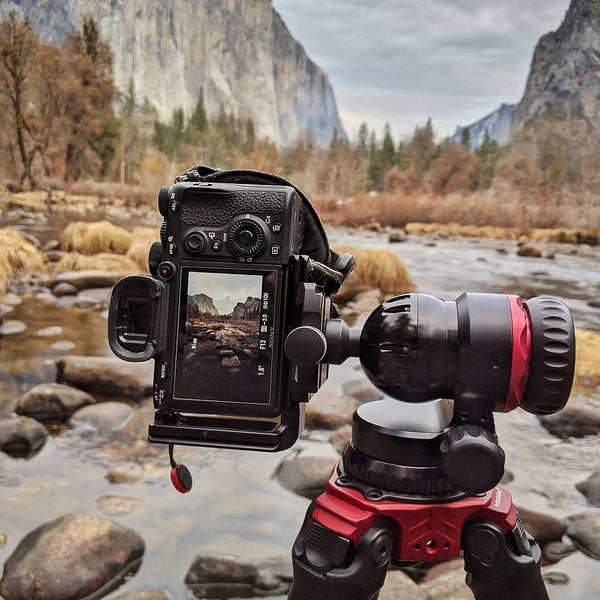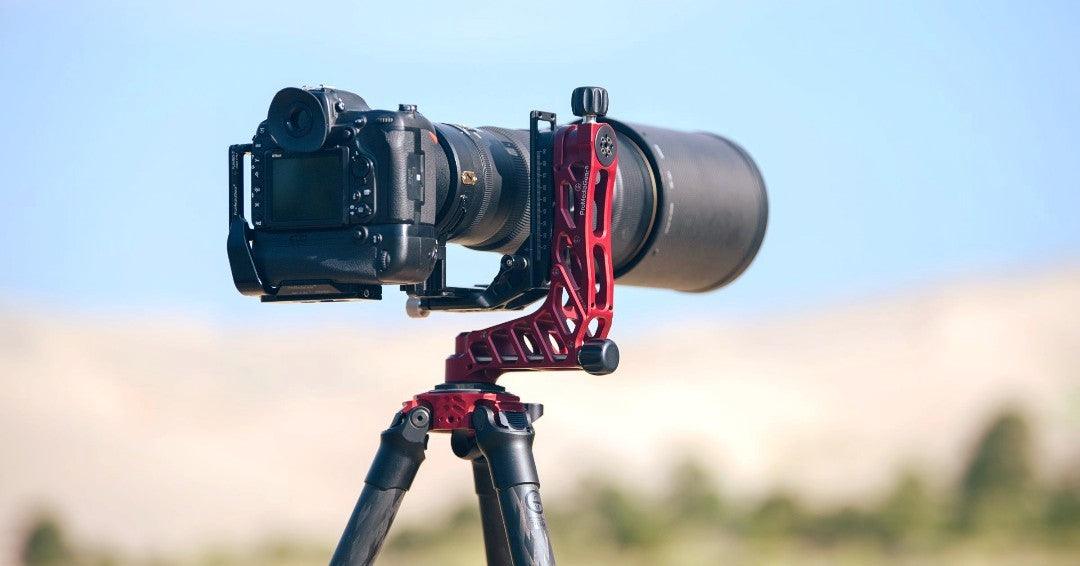There are multiple types of tripod heads available in the market today but not all of them are ideal for wildlife photography. The best tripod head for wildlife photography allows you to shoot comfortably without compromising durability.
Buying a tripod head for wildlife and bird photography is challenging because you need to consider a lot of factors - durability, reliability, smoothness, ergonomics, and a whole lot more.
There are two main tripod heads to consider for shooting animals. The ball head and the gimbal head are both great choices but what are the advantages over the other? Let’s find out.

What is a ball head? What are the advantages?
The ball head is one of the most common types of tripod heads available. It is often seen on affordable tripod sets and professional tripod setups.
Ball heads are easy to adjust - often with one large knob to unlock and secure the camera into place. Some models also have a smaller lock for panning.
There are ball heads that may support huge telephoto lenses and cameras, but these cost a lot. Affordable models often have a weight limit that is not suitable for heavy setups.
However, if you are just starting out in your wildlife photography journey, then a ball head is a great option.
Now, the main disadvantage of using a ball head is its precision.
When you unlock the ball head, the whole plane is unlocked. You may try to adjust the angle to the right and you will unknowingly tilt the camera thus ruining a perfectly level shot. One small movement affects the camera setup.

What is a gimbal head? What are the advantages?
The gimbal head is considered the “holy grail” of wildlife photography. This means that it is considered the best option when it comes to shooting wildlife or any fast-moving subject.
This tripod head is a must-have for any wildlife photographer especially if you shoot with large telephoto lenses. Super telephoto lenses are heavy and if you try to shoot with one handheld, it won’t take long until you feel the fatigue.
A gimbal head balances a camera and lens setup right at its center of gravity. This gives you the freedom to move the lens anytime you want and leave it at a certain position.
For example, you are shooting a scene and you suddenly want to track an animal, then doing so is easy with a gimbal head.
So what are the disadvantages of using one?
The problem with gimbal heads is their size. It is not as compact as ball heads and some models are heavy too. But this con is definitely outweighed by the benefit it brings.

What are the other tripod head options?
Besides the two mentioned earlier, there are other tripod heads available in the market.
Pan-Tilt Heads
Pan-tilt heads are an excellent first choice for photographers. It has an independent lock for panning and tilting, hence the name. It is more precise than a ball head due to these independent knobs.
The downside with this type of tripod head is speed. It is slower to use compared to a gimbal head and a ball head. The handles are bulky too.
The good thing though is these tripod heads are affordable. Some beginner tripods under $50 even include one by default.
There is a variation of the Pan-Tilt Head called Geared Heads. This version has gears for micro-adjustments.

Fluid Heads
Fluid heads are video-oriented tripods that have a sealed liquid inside that ensures smooth panning movements. This would have been perfect for wildlife too due to its smooth movement. However, due to the quick non-linear movement of animals, using a fluid head is not suggested.
Pistol Heads
Pistol heads have the same concept as ball heads, but the lock is triggered by a pistol grip. You just have to squeeze the pistol grip and you are free to move your camera. The downside is the difficulty of controlling your camera and holding the grip at the same time.
What is the best tripod head for wildlife photography?
In the end, the battle between the best tripod head for wildlife photography is between the ball head and the gimbal head with the latter taking the top spot.
If your budget permits, then the gimbal head is the way to go. They provide a smoother and easier operation compared to a ball head. Using one with a super-telephoto lens will make it seem like the heavy lens is weightless once balanced.

The lightness of the setup with a gimbal head makes tracking animals in the wild a piece of cake. All you have to do is to point your camera and compose your image.
Meanwhile, a ball head offers a versatile approach to shooting regardless of the photography genre and the gear you have. It is not as smooth as the gimbal head when tracking but it can still get the job done.
So there it is, the gimbal head is your best option. The ball head is versatile, but for this specific photography genre, a gimbal head is a must.
What is the best gimbal head?
The ProMediaGear GKJr Katana Pro is one of the best gimbal heads you can get for wildlife photography. It is lightweight, durable, and has received tons of positive feedback from its users.
The main advantage of the Katana Pro over its competitors is its weight. The company has designed it to shed as much weight as possible without compromising quality. In the end, ProMediaGear managed to create a stunning gimbal head that operates smoothly.

Gimbal + Ball Head: The best of both worlds
There is an option if you want to maximize the ball head and gimbal head at the same time. The GT1 Tomahawk Gimbal Attachment for ball heads allows you to get the best of both worlds.
There is also an upgraded version called the GT2 Tomahawk Gimbal. It is smaller, lighter, and more portable than the GT1.
This gimbal attachment works by mounting to any Arca-type ball head. Once attached, it will work the same as a regular side-mounted gimbal head.
So what are the advantages of using the GT1 or GT2 Tomahawk?
Versatility is one of the reasons why you might want to consider a gimbal ball head attachment. If you have a regular shoot, you take it off and use the ball head.
When you are out shooting fast-moving subjects like sports and wildlife, pop it in your ball head and you have a fully functional gimbal head by your fingertips.
Of course, the downside is you will have to carry two tripod heads instead of one. But considering the functionality it provides, it is worth considering especially now that the GT2 is lighter and easier to carry.
Final Thoughts
The best tripod head for wildlife photography is the gimbal head since it works smoother and allows for fluid non-linear movement. This is essential whenever you need to track wild animals.
However, the other type of tripod heads are still capable of doing the job. It works, but it is not optimal.
That said, do not forget to share your wildlife photography photos with us on Instagram @ProMediaGear or join our Facebook ProMediaGear group.

